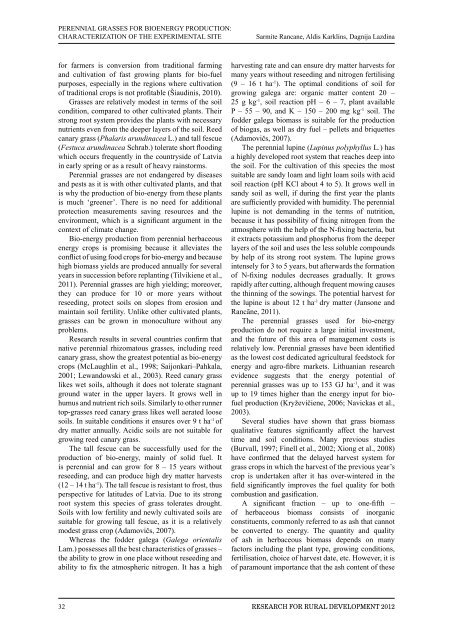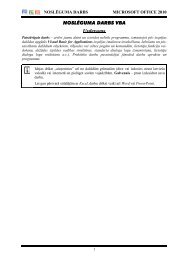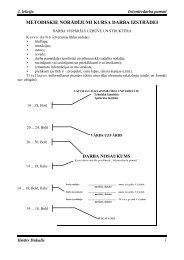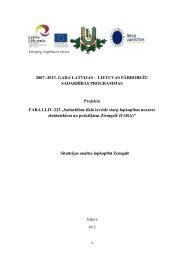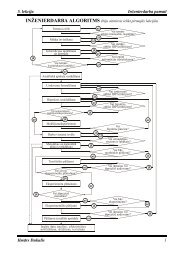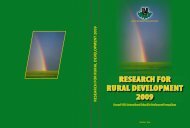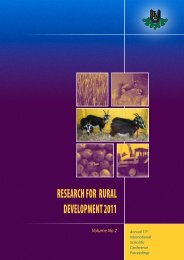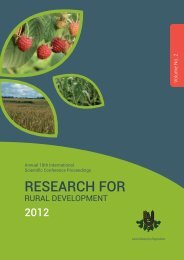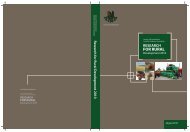LATVIA UNIVERSITY OF AGRICULTURE - Latvijas ...
LATVIA UNIVERSITY OF AGRICULTURE - Latvijas ...
LATVIA UNIVERSITY OF AGRICULTURE - Latvijas ...
- No tags were found...
Create successful ePaper yourself
Turn your PDF publications into a flip-book with our unique Google optimized e-Paper software.
PERENNIAL GRASSES FOR BIOENERGY PRODUCTION:CHARACTERIZATION <strong>OF</strong> THE EXPERIMENTAL SITESarmite Rancane, Aldis Karklins, Dagnija Lazdinafor farmers is conversion from traditional farmingand cultivation of fast growing plants for bio-fuelpurposes, especially in the regions where cultivationof traditional crops is not profitable (Šiaudinis, 2010).Grasses are relatively modest in terms of the soilcondition, compared to other cultivated plants. Theirstrong root system provides the plants with necessarynutrients even from the deeper layers of the soil. Reedcanary grass (Phalaris arundinacea L.) and tall fescue(Festuca arundinacea Schrab.) tolerate short floodingwhich occurs frequently in the countryside of Latviain early spring or as a result of heavy rainstorms.Perennial grasses are not endangered by diseasesand pests as it is with other cultivated plants, and thatis why the production of bio-energy from these plantsis much ‘greener’. There is no need for additionalprotection measurements saving resources and theenvironment, which is a significant argument in thecontext of climate change.Bio-energy production from perennial herbaceousenergy crops is promising because it alleviates theconflict of using food crops for bio-energy and becausehigh biomass yields are produced annually for severalyears in succession before replanting (Tilvikiene et al.,2011). Perennial grasses are high yielding; moreover,they can produce for 10 or more years withoutreseeding, protect soils on slopes from erosion andmaintain soil fertility. Unlike other cultivated plants,grasses can be grown in monoculture without anyproblems.Research results in several countries confirm thatnative perennial rhizomatous grasses, including reedcanary grass, show the greatest potential as bio-energycrops (McLaughlin et al., 1998; Saijonkari–Pahkala,2001; Lewandowski et al., 2003). Reed canary grasslikes wet soils, although it does not tolerate stagnantground water in the upper layers. It grows well inhumus and nutrient rich soils. Similarly to other runnertop-grasses reed canary grass likes well aerated loosesoils. In suitable conditions it ensures over 9 t ha -1 ofdry matter annually. Acidic soils are not suitable forgrowing reed canary grass.The tall fescue can be successfully used for theproduction of bio-energy, mainly of solid fuel. Itis perennial and can grow for 8 – 15 years withoutreseeding, and can produce high dry matter harvests(12 – 14 t ha -1 ). The tall fescue is resistant to frost, thusperspective for latitudes of Latvia. Due to its strongroot system this species of grass tolerates drought.Soils with low fertility and newly cultivated soils aresuitable for growing tall fescue, as it is a relativelymodest grass crop (Adamovičs, 2007).Whereas the fodder galega (Galega orientalisLam.) possesses all the best characteristics of grasses –the ability to grow in one place without reseeding andability to fix the atmospheric nitrogen. It has a highharvesting rate and can ensure dry matter harvests formany years without reseeding and nitrogen fertilising(9 – 16 t ha -1 ). The optimal conditions of soil forgrowing galega are: organic matter content 20 –25 g kg -1 , soil reaction pH – 6 – 7, plant availableP – 55 – 90, and K – 150 – 200 mg kg -1 soil. Thefodder galega biomass is suitable for the productionof biogas, as well as dry fuel – pellets and briquettes(Adamovičs, 2007).The perennial lupine (Lupinus polyphyllus L.) hasa highly developed root system that reaches deep intothe soil. For the cultivation of this species the mostsuitable are sandy loam and light loam soils with acidsoil reaction (pH KCl about 4 to 5). It grows well insandy soil as well, if during the first year the plantsare sufficiently provided with humidity. The perenniallupine is not demanding in the terms of nutrition,because it has possibility of fixing nitrogen from theatmosphere with the help of the N-fixing bacteria, butit extracts potassium and phosphorus from the deeperlayers of the soil and uses the less soluble compoundsby help of its strong root system. The lupine growsintensely for 3 to 5 years, but afterwards the formationof N-fixing nodules decreases gradually. It growsrapidly after cutting, although frequent mowing causesthe thinning of the sowings. The potential harvest forthe lupine is about 12 t ha -1 dry matter (Jansone andRancāne, 2011).The perennial grasses used for bio-energyproduction do not require a large initial investment,and the future of this area of management costs isrelatively low. Perennial grasses have been identifiedas the lowest cost dedicated agricultural feedstock forenergy and agro-fibre markets. Lithuanian researchevidence suggests that the energy potential ofperennial grasses was up to 153 GJ ha -1 , and it wasup to 19 times higher than the energy input for biofuelproduction (Kryževičiene, 2006; Navickas et al.,2003).Several studies have shown that grass biomassqualitative features significantly affect the harvesttime and soil conditions. Many previous studies(Burvall, 1997; Finell et al., 2002; Xiong et al., 2008)have confirmed that the delayed harvest system forgrass crops in which the harvest of the previous year’scrop is undertaken after it has over-wintered in thefield significantly improves the fuel quality for bothcombustion and gasification.A significant fraction – up to one-fifth –of herbaceous biomass consists of inorganicconstituents, commonly referred to as ash that cannotbe converted to energy. The quantity and qualityof ash in herbaceous biomass depends on manyfactors including the plant type, growing conditions,fertilisation, choice of harvest date, etc. However, it isof paramount importance that the ash content of these32 Research for Rural Development 2012


